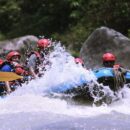If you enjoy bass fishing, you should know that they are aggressive predators challenging to catch.
Therefore, you should know a few things about catching them before you start with the process. You can easily find some great bass articles which will help you understand more about seeing them in the first place.
For instance, late autumn is the best time to start doing it. Therefore, you should get your gear and head out on a fishing adventure after checking out the tips we present to you in the further article.
Let us start from the beginning.
Tricks for Catching Bass

- Stay Safe – It doesn’t matter whether you are fishing from a shore or boat because you should follow safety measures to ensure that everything goes according to plan. Therefore, you should wear a life jacket, obtain an exit strategy from beaches and rocks, which will help you catch and return bass from a particular position. If you wish to do it with your friend, it is a way safer option. However, doing it alone means you should let your friends or family members know where you are. Besides, you have to return it when you catch it and take a picture with it. If you wish to go for a private fishing experience, check out fishing charter St Thomas, Vi.
- Consider a Tide Beforehand – If you wish to plan a bass trip, we recommend determining a tide beforehand. That way, you can maximize your chances of returning and fishing, which will increase overall safety. You can visit different websites that will help you predict the best course of action. Besides, you should check out sea temperatures and weather forecasts before you set sail.
You should click here to learn more about this particular type of fish.
- Dusk or Dawn – It is essential to understand that dusk and dawn are the best times when you can catch them because they are more likely to feed in these moments. During a first light, they will go feeding, which is something you should remember beforehand. However, everything depends on your work routine. You can also choose to fish after dark by using poppers and lures, which can be interesting, but always bring someone with you just in case.
- Check for Different Structures – You can find bass next to different structures because they tend to find prey in these areas. Therefore, you should check out for structures including moorings, sandbanks, groynes, jetty legs, and snags before you make up your mind. You can take advantage of technology and mark these areas on Google Maps to ensure that you find them easily.
- Avoid Overcasting – You should know that basses are widely known for striking close, which means that you should search them next to your boat or your feet, even if it seems problematic. We recommend using a fly and luring it to the edge while exploring incoming tide and newly flooded areas throughout a process.
- Adapt to Particular Situations – You should avoid stereotypical perspectives while fishing for bass because choosing lures and flies are perfect in calm and clear seas. At the same time, they are ideal next to shoals and structures. However, if it is stirred at the bottom, you should find a different bait to catch them. Therefore, you should offer a mackerel or crab, which are baits you should always have as a backup. You can also use float gear, including sandeel and ragworms, which will help you.
- Choose Large Gear – If you wish to increase the chances of pulling out a large brass, you should use a large hook as well. Keep in mind that they are greedy and come with giant mouths, which means they will quickly break down smaller hooks.
- Use Different Preys – You can find white livery based on the fly’s color and size, which you should remember beforehand. Therefore, you should vary based on the retrieved rate, which will allow you to replicate eel movement with ease. Avoid being patient and waiting for it in a single spot, but use different tactics to help you out with the process.
Check out this guide: https://www.wikihow.com/Fish-for-Bass to learn how to catch a bass with ease.
- Let Biggest Ones Go – The rules and regulations about retaining bass are strict. Therefore, if you wish to keep it, we recommend getting it up to forty-two centimeters. On the other hand, if you find a large one, it is way better to return it to ensure that you can return to a place because it will become breeding stock.























